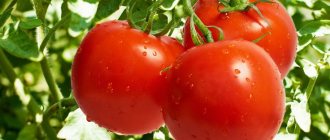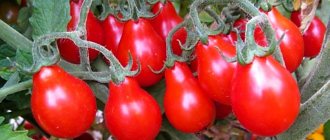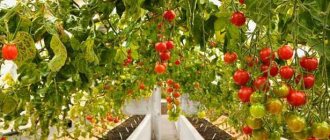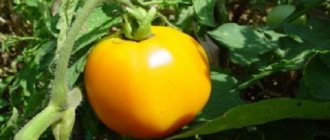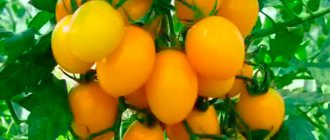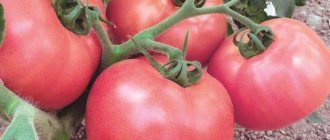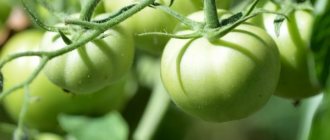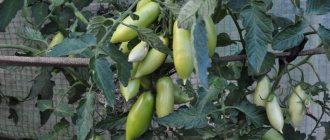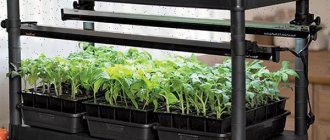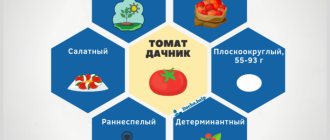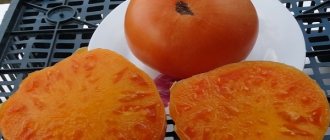Tomato seeds Asvon F1 are products of the famous Dutch agricultural company Kitano. This hybrid has outstanding economic characteristics. It has not yet been zoned in our country, but many summer residents have become convinced of the excellent qualities of the tomato and left reviews about their successful experience in growing Dutch tomatoes.
| Height | Landing location | Ripening time | Fruit color | Fruit size | Origin | Fruit shape |
| Medium height | Open ground | Early ripening | Reds | Small | Hybrid | Round |
Tomato “Asvon F1”: description of the variety
| Variety name | Asvon |
| general description | Early maturing, high-yielding hybrid of the first generation |
| Originator | Russia |
| Ripening period | 85-90 days |
| Form | Tomatoes are round-cuboidal, with slightly pronounced ribbing |
| Color | Red |
| Average weight of tomatoes | 70-100 grams |
| Application | Universal |
| Productivity of the variety | 2.5-4 kg per square meter |
| Features of cultivation | Agricultural technology is standard. Tomatoes are sensitive to soil nutrition |
| Disease resistance | Resistant to most diseases |
The hybrid was bred by Russian breeders and zoned for regions with temperate and warm climates. It is possible to grow in open ground, greenhouses, under film and in greenhouses. The yield is good, the fruits are stored for a long time and can be transported.
Asvon F1 is an early-ripening, high-yielding hybrid of the first generation. The bush is determinate, compact, with abundant formation of green mass. Read about indeterminate varieties here. The leaves are medium sized, dark green. The fruits ripen in double clusters of 5-6 pieces. The yield is excellent; up to 9 kg of selected tomatoes can be harvested from one bush. During the fruiting period, small bushes are simply strewn with fruits and look very decorative.
| Variety name | Productivity |
| Asvon | 9 kg per bush |
| Boni M | 14-16 kg per square meter |
| Aurora f1 | 13-16 kg per square meter |
| Leopold | 3-4 kg per bush |
| Sanka | 15 kg per square meter |
| Argonaut f1 | 4.5 kg per bush |
| Kibitz | 3.5 kg per bush |
| Heavyweight of Siberia | 11-12 kg per square meter |
| Honey cream | 4 kg per square meter |
| Ob domes | 4-6 kg per bush |
| Marina Grove | 15-17 kg per square meter |
Landing
Seeds of hybrid tomatoes can be sold processed or unprocessed - information about this is on the packaging. Untreated seeds should be prepared for planting yourself. They are placed in a pale pink solution of potassium permanganate for 20 minutes, after which they are washed in running water and immersed in a solution of trace elements (half a tablet per glass of water). Instead of potassium permanganate, you can use a 20-minute soak in a 3% solution of hydrogen peroxide. This substance not only disinfects the surface of the seeds, but also accelerates their germination.
The planting material is kept in the microelement solution for 12 hours. After this, without drying or washing, they are sown in seedling boxes to a depth of 1 cm.
To obtain an early harvest, tomatoes are grown through seedlings. Sowing is carried out in February. Seedlings are planted under film covers in the second ten days of April. In the phase of full germination and the formation of the first true leaf, the seedlings are planted according to a 5 by 5 cm pattern. 400-500 seedlings are placed per square meter.
During cultivation, seedlings are fed two or three times - the second time two days before planting and combined with abundant watering. The height of the finished seedlings is 13-15 cm. Plants sown at a later date are grown without picking, transplanting the seedlings directly into the garden bed.
Asvon F1 is planted in rows every 20 cm, leaving wide row spacing - 90 cm. Thickening stimulates tomato bushes to increase fruiting on the periphery, which simplifies harvesting.
In order for seedlings to quickly take root in open ground, a day before planting they are sprayed with adaptogens: Epin or Silk solution. It has been proven that treatment with Epin enhances the ability of plants to resist cold. Silk, on the contrary, increases heat resistance. Depending on the region in which the plants will be grown, the seedlings are treated with the appropriate adaptogen.
Application of Silk:
- the package of the drug is dissolved in 1.5 liters of water;
- spray the leaves, trying not to get on the ovaries and flowers (if any).
Application of Epin:
- 1 ml of product is dissolved in 5 liters of water;
- spray the leaves.
Advantages and disadvantages
Among the main advantages of the variety:
- early fruit ripening;
- high taste of tomatoes;
- good yield;
- resistance to diseases.
No shortcomings were noticed in the hybrid. The only peculiarity is that tomatoes are demanding in terms of soil nutrition . On poor soils, yields are significantly reduced.
Criterias of choice
Typically, each gardener chooses short tomatoes based on his own preferences for ripening time, size and color of the fruit, and taste characteristics. In addition, several other factors should be taken into account:
Features of the greenhouse. For summer buildings (for example, made of cellular polycarbonate), it is better to choose early-ripening varieties that are resistant to temperature changes or extreme heat.
For heated winter rooms, you should pay attention to options with a short growing season and tolerance to a lack of sunlight. If there are problems with water supply, you need to plant plants that are drought-resistant and not prone to cracking.
Growing goals
For personal needs, it is enough to focus on your tastes; for subsequent sales, give preference to high-yielding and transportable varieties.
Related article:
Why do tomatoes have white streaks inside?
Purpose of tomatoes. It is advisable to decide in advance on the required quantity of early vegetables and those that will be used for storage and preparation, including separately for their different types. For example, for whole-food preservation it is worth focusing on small- and medium-fruited varieties; for fresh salads, processing into tomato juice and similar products, large fruits are suitable.
Disease prognosis. In closed ground, pathogenic microorganisms accumulate more, and when growing only tomatoes in a greenhouse for several seasons in a row (without crop rotation), the risk of infectious diseases increases significantly
In this case, it is recommended to pay attention to the latest disease-resistant hybrids. And when choosing non-hybrid forms, you need to think through the process of disinfecting seeds and the greenhouse, ventilation and subsequent treatments.
Read about varieties of low-growing tomatoes for open ground in the article
Characteristics
The tomatoes are round-cuboidal, with slightly pronounced ribbing, shiny skin, which protects the fruit from cracking. The weight of tomatoes ranges from 70 to 100 g. The pulp is dense, the tomatoes hold their shape well. The taste is rich, sweet, without wateriness. High content of sugars and solids (up to 6%). The color of ripe tomatoes is bright red-pink, without green spots at the stalk.
You can compare the weight of this variety with others in the table below:
| Variety name | Fruit weight |
| Asvon | 70-100 grams |
| White filling | 100g |
| Ultra early maturing F1 | 100g |
| Striped chocolate | 500-1000 grams |
| Banana Orange | 100g |
| King of Siberia | 400-700 grams |
| Pink honey | 600-800 grams |
| Rosemary pound | 400-500 grams |
| Honey-sugar | 80-120 grams |
| Demidov | 80-120 grams |
| Dimensionless | up to 1000 grams |
Tomatoes are ideal for canning; the dense flesh does not crack; pickled or salted fruits look very elegant. It is possible to stuff, prepare salads or side dishes. The fruits are tasty fresh.
Tomato hybrids
Let's see which varieties of truss tomatoes are the best for greenhouses. If in the south tomatoes bear fruit well in the ground, they are planted in a greenhouse exclusively for very early or late harvesting, but in the north the situation is different. Even though tomatoes are grown in greenhouses there, weather conditions still affect their growth. Low temperatures and cloudy weather do not have the best effect on the development of even greenhouse vegetables - not every greenhouse is equipped with central heating and uninterrupted electric lighting. In addition, any additional energy costs affect the cost of tomatoes. Here we need hybrids that can successfully grow and bear fruit even in conditions of low temperature and lack of lighting.
Often tomatoes suitable for planting in southern regions are not suitable for cold climates. But it would be wrong to think that southern varieties cannot be grown in the north, but by transferring northern varieties to the south, we will get a miracle harvest. We may not get it at all. Northern tomatoes simply will not survive the hot southern summer - they are simply not designed for it.
We will consider exclusively truss greenhouse hybrids, and we will pay more attention to those tomatoes that grow in cold climates
True friends F1
A carpal hybrid with an early ripening period reaching a height of 2 meters. The fruits are round, tight, red, weighing up to 100 g. Usually the cluster contains from 7 to 12 simultaneously ripening fruits, aligned in size. Productivity is consistently high, up to 9 kg per bush. Suitable for recycling.
Resistant to temperature fluctuations. It performed well when grown in cold climates.
Intuition F1
A cluster hybrid with good yield and early ripening - almost 110 days pass from the moment the first shoots peck to the formation of ripe tomatoes. Round tomatoes weighing 100 g are red, have a long shelf life, and are not prone to cracking. They are not inferior in taste to the best Dutch hybrids. Developed specifically for collection by brushes.
Resistant to critical weather conditions and all major tomato diseases. Suitable for growing in northern Russia.
Instinct F1
Tall hybrid with a medium ripening period and fruits weighing up to 110 g. Very easy to grow.
Resistant to lack of light. Can be grown in cold climates.
Carpal F1
Super-yielding mid-early carpal hybrid. The fruits are red, dense, round, weighing up to 110 g. Suitable for canning. Stores well in brushes.
Resistant to stress, fruits set well even with a lack of light and heat. Fruits well in greenhouses in cold regions.
Comet F1
Large-fruited carpal hybrid, bred by Dutch breeders. It is a powerful, easy-to-care plant of medium height with round red fruits. The clusters are uniform, with fruits weighing up to 180 g. They need to be pinched, leaving 5 ovaries.
Recommended for collection with brushes. Requires good lighting. A very productive hybrid, popular in many countries, suitable for cultivation in any climatic conditions.
Features of cultivation
Tomatoes of the Asvon F1 variety can be grown in seedlings or without seedlings. The seeds are treated with a growth stimulant. The soil should be nutritious and light; a mixture of sandy soil with humus is ideal; you can prepare it yourself.
When using the seedling method, seeds are sown in containers or peat cups with a small depth; special mini-greenhouses can be used. In the phase of formation of the first pair of true leaves, the seedlings are planted and then fed with liquid complex fertilizer.
Tip: When growing without seedlings, seeds are sown in soil fertilized with humus. The plantings are sprayed with water and covered tightly with film. As a result, tomatoes grow strong, strong, and do not require hardening.
Adult plants are watered abundantly, but not too often. During the season, tomatoes need to be fed at least 4 times, alternating organic matter with mineral complexes. Foliar feeding is useful, for example spraying with an aqueous solution of superphosphate.
Read more about a variety of fertilizers for tomatoes:
- Complex, phosphorus, ready-made, TOP of the best.
- Yeast, ash, iodine, hydrogen peroxide, ammonia, boric acid.
- For seedlings, when picking.
There is no need to form compact bushes; if necessary, the branches can be tied to a support. It is recommended to remove the lower leaves to allow air and sun access to the fruit. Mulching will help control weeds.
Care
The first watering is carried out 1.5 weeks after transplantation. in the future – at intervals of 5 days. Using warm water, pour 5-6 liters under each plant. After this, the top layer of soil is loosened and weeds are removed.
It is impossible for the root system to experience a lack of space. The formation of a bush is not required, because side shoots appear in small numbers. Considering that a large number of fruits are formed on the bushes, garters are required. To prevent moisture evaporation, you will need to mulch the root part. For this, either straw or humus is used.
Fertilizers
During the season, Asvon F1 tomatoes are fed several times.
- 2 weeks after planting, the plants are fed with nitrogen fertilizers: ammonium nitrate or urea 20-30 g per 1 square meter.
- After 3 weeks, use complex fertilizers (nitrophoska, ammophos, azophoska) containing nitrogen, phosphorus and potassium - 30-40 g per 1 sq. m.
- A week before harvesting vegetables - phosphorus-potassium fertilizers: superphosphate - 25-30 g and potassium sulfate 30-40 g per 1 square meter.
When fertilizing, fresh bird droppings or manure should not be used. Only their infusions are used.
Disease and pest control
The culture is resistant to diseases and pests. It is extremely rarely affected by anthracnose and nematodes. Vofatox solution (2 ampoules per 10 liters of water) helps fight them.
1000 kg from 1 hundred square meters tomato asvon f1
Growing tomato Asvon F1
